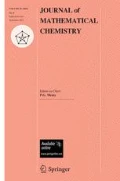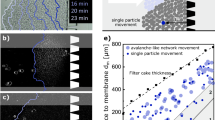Abstract
This paper investigates the potential use of carbon nanocones as selective filtration devices. Using a continuum approach and the Lennard-Jones potential, we determine the energy of truncated carbon nanocones interacting with ions (Na\(^{+}\) and Cl\(^{-}\)) and water molecules. The Verlet algorithm is adopted to determine the dynamics of the ions and the water molecules as a result of the interaction with the nanocones. The acceptance energy is derived to determine the minimum and critical radii of the truncated nanocones that block the ions and allow only water molecules to pass through. Our results show that the channel with apex angle of \(19.2^{\circ}\) and opening radius in the range 3.368–3.528 Å gives highest suction energy.





Similar content being viewed by others
References
M. Ge, K. Sattler, Observation of fullerene cones. Chem. Phys. Lett. 220, 192–196 (1994)
A. Krishnan, E. Dujardin, N.M.J. Treacy, J. Hugdahl, S. Lynum, T.W. Ebbesen, Graphitic cones and the nucleation of curved carbon surfaces. Nature 388, 451–454 (1997)
H. Heiberg-Andersen, A.T. Skjeltorp, K. Sattler, Carbon nanocones: a variety of non-crystalline graphite. J. Non-Cryst. Solids. 354, 5247–5249 (2008)
S.N. Naess, A. Elgsaeter, G. Helgessen, K.D. Knudsen, Carbon nanocones: wall structure and morphology. Sci. Technol. Adv. Mater. 10, 065002 (2009)
D. Ma, H. Ding, X. Wang, N. Yang, X. Zhang, The unexpected thermal conductivity from graphene disk, carbon nanocone to carbon nanotube. Int. J. Heat Mass Transf. 108, 940–944 (2017)
P.-C. Tsai, T.-H. Fang, A molecular dynamics study of the nucleation, thermal stability and nanomechanics of carbon nanocones. Nanotechnology 18, 105702 (2007)
J.X. Wei, K.M. Liew, X.Q. He, Mechanical properties of carbon nanocones. Appl. Phys. Lett. 91, 261906 (2007)
K.M. Liew, J.X. Wei, X.Q. He, Carbon nanocones under compression: buckling and post-buckling behaviors. Phys. Rev. B 75, 195435 (2007)
J.C. Charlier, G.M. Rignanese, Electronic structure of carbon nanocones. Phys. Rev. Lett. 86, 5970–5973 (2001)
R. Pincak, V.A. Osipov, Localized electron states near pentagons in variously shaped carbon nanoparticles. Phys. Lett. A 314, 315–321 (2003)
N. Karousis, I.S. Martinez, C.P. Ewels, N. Tagmatarchis, Structure, properties, functionalization, and applications of carbon nanohorns. Chem. Rev. 116, 4850–4883 (2016)
C. Mannaris, B.M. Teo, A. Seth, L. Bau, C. Coussios, E. Stride, Gas-stabilizind gold nanocones for acoustically mediated drug delivery. Adv. Healthc. Mater. 7, 1800184 (2018)
I.C. Chen, L.H. Chen, A. Gapin, S. Jin, L. Yuan, S.H. Liou, Iron-platinum-coated carbon nanocone probes on tipless cantilevers for high resolution magnetic force imaging. Nanotechnology 19, 075501 (2008)
O.O. Adisa, B.J. Cox, J.M. Hill, Open carbon nanocones as candidates for gas storage. J. Phys. Chem. C 115, 24525–24533 (2011)
Y. Zhang, G.C. Schatz, Conical nanopores for efficient ion pumping and desalination. J. Phys. Chem. Lett. 8, 2842–2848 (2017)
W. Li, W. Wang, Y. Zhang, Y. Yan, P. Král, J. Zhang, Highly efficient water desalination in carbon nanocones. Carbon 129, 374–379 (2018)
T. Humplik, J. Lee, S.C. O’Hern, B.A. Fellman, M.A. Baig, S.F. Hassan, M.A. Atieh, F. Rahman, T. Laoui, R. Karnik, E.N. Wang, Nanostructured materials for water desalination. Nanotechnology 22, 292001 (2011)
Q. Shi, H. Gao, Y. Zhang, Z. Meng, D. Rao, J. Su, Y. Liu, Y. Wang, R. Lu, Bilayer graphene with ripples for reverse osmosis desalination. Carbon 136, 21–27 (2018)
X.W. Meng, J.P. Huang, Enhanced permeation of single-file water molecules across a noncylindrical nanochannel. Phys. Rev. E 88, 014104 (2013)
M. Wang, X. Xu, Y. Li, T. Lu, L. Pan, Enhanced desalination performance of anion-exchange membrane capacitive deionization via effectively utilizing cathode oxidation. Desalination 443, 221–227 (2018)
L.A. Girifalco, M. Hodak, R.S. Lee, Carbon nanotubes, buckyballs, ropes, and a universal graphitic potential. Phys. Rev. B 62(19), 13104–13110 (2000)
L. Verlet, Computer “experiments” on classical fluids. I. Thermodynamical properties of Lennard-Jones molecules. Phys. Rev. 159, 98 (1967)
Y. Chan, Y. Ren, Mathematical modeling and simulations on massive hydrogen yield using functionalized nanomaterials. J. Math. Chem. 53, 1280–1293 (2015)
F. Rahmat, N. Thamwattana, B.J. Cox, Modelling peptide nanotubes for artificial ion channels. Nanotechnology 22, 445707 (2011)
J.O. Hirschfelder, C.F. Curtiss, R.B. Bird, Molecular Theory of Gases and Liquids (Wiley, New York, 1964)
A .K. Rappé, C .J. Casewit, K .S. Colwell, W .A. Goddard III, W .M. Skiff, UFF, a full periodic table force field for molecular mechanics and molecular dynamics simulations. J. Am. Chem. Soc. 114, 10024–10035 (1992)
I .S. Gradshteyn, I .M. Ryzhik, Table of Integrals, Series, and Products, 7th edn. (Academic Press, Cambridge, 2007)
B .J. Cox, N. Thamwattana, J .M. Hill, Mechanics of atoms and fullerenes in single-walled carbon nanotubes. I. Acceptance and suction energies. Proc. R. Soc. A 463, 461–477 (2007)
R. Chang, J. Overby, Chemistry, 11th edn. (McGraw-Hill Education, New York, 2014)
Acknowledgements
NT is grateful to the Faculty of Science at the University of Newcastle for her startup fund and to the Australian Research Council for the funding of Discovery Project DP170102705. DB acknowledges the Thailand Research Fund RSA6180076.
Author information
Authors and Affiliations
Corresponding author
Additional information
Publisher's Note
Springer Nature remains neutral with regard to jurisdictional claims in published maps and institutional affiliations.
Rights and permissions
About this article
Cite this article
Sarapat, P., Thamwattana, N., Cox, B.J. et al. Modelling carbon nanocones for selective filter. J Math Chem 58, 1650–1662 (2020). https://doi.org/10.1007/s10910-020-01153-y
Received:
Accepted:
Published:
Issue Date:
DOI: https://doi.org/10.1007/s10910-020-01153-y




